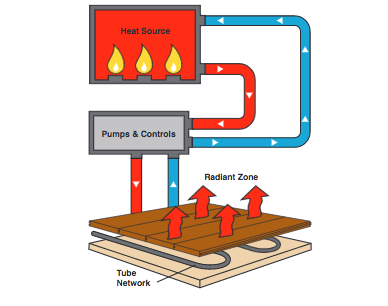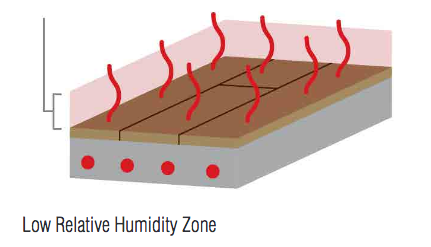Radiant Floor Heating Education Guide
Radiant Floor Heating Education Guide or radiant heat installation guidelines, must be read thoroughly before installing the floors.
Hallmark Floors’ hardwood flooring is an exceptional choice for installation over hydronic radiant heat (warm water). We use only true hardwood veneers and Carb II complaint glues for the center-ply in our engineered floors. The center veneers are cold pressed, then hot pressed with tremendous pressure. This process makes the center core Eco friendly. It makes our engineered wood floors harder and more proportionally stable. Hallmark Floors is a better choice for in floor radiant heat systems.
Flooring Products Suitable for Installation over Radiant Heat:
Engineered Hardwood Floors:
Organic 567 – Engineered only (excluding Hickory)
Alta Vista – All
Moderno – All (excluding Hickory)
Monterey – All (excluding Hickory)
Novella – All (excluding Hickory)
Ventura – All
Heirloom – All (excluding Hickory)
Hacienda – All (excluding Hickory)
Silverado – All
Chaparral – All (excluding Hickory)
Luxury Vinyl Floors:
Waterproof Rigidl – All
Waterproof Luxury Vinyl – All
PVP Vinyl – All
PVC Free Vinyl
Benefits of a Hallmark Floors floating floor over hydronic radiant heat systems include:
1. No nailing required, eliminating the risk of puncturing the in-floor tubing that exists with nail-down applications.
2. The floor is not glued directly to the thermal mass, eliminating potential loss-of-bond issues.
3. Floor Muffler or equivalent pads do not add substantial R Value resistance to the installation and keep the system energy efficient. This, combined with the thinner overall thickness, our engineered floors have lower R Values than traditional, solid wood floors.
NOTE: Hallmark Hickory and Solid Hardwood Flooring excluded from Radiant Heat Installation Method.
Radiant Heat FAQ – Frequently Asked Questions
Radiant Heat Systems: In-floor heating systems must be water based, and designed to prevent the surface temperature of the hardwood floor from exceeding 85º F.
Q. At what point should a Hallmark Floors hardwood floor be installed?
A. Hardwood flooring should be the last item installed on the radiant heat floor project. All windows and doors must be in place and the structure completely weather tight. If the tubing is encased in lightweight concrete, the concrete must be completely dry. Kitchen cabinets must be in place prior to installation of the floor. The relative humidity conditions must be between 30 and 55%, and the temperature between 65 and 85 degrees F.
Q. How long before installation of the floor should the radiant heat system be powered on?
A. Two to three weeks prior to installation of the hardwood flooring with the thermostat set at 70º F and then at 85º F for 3 more days. The home should be aired out briefly everyday to allow excess humidity from the thermal mass to exhaust moisture out of the structure.
Q. What should the moisture content of the lightweight concrete be before installation?
A. The lightweight concrete moisture content must not exceed 1.5% as measured with a Tramax Moisture Encounter meter.
Q. Do the floors move?
A. A floating floor with have a degree of resilience, or give that a nail-or-glue-down floor does not have.
Q. Do the floors gap or expand and contract?
A. Hardwood flooring is a natural product and will change size with variations in temperature and moisture content. However, engineered hardwood floors are far more proportionally stable than solid hardwood floors. Good humidity control can minimize these changes even more with radiant floor heating.
Q. What constitutes a low humidity environment?
A. This varies by geography but is usually defined by areas that experience long periods of freezing weather or have naturally low humidity like the deserts or higher elevations present in the mountains (below 30% humidity).
Q. Should the floor be acclimated?
A. Since the floor is engineered, as such it is pre-acclimated to a 30 to 55% environment. As such long acclimation times are not required. Place the material on site 24 hours prior to installation.
Q. Should radiant heat be turned on before weather becomes cold?
A. Radiant heat should be turned on at low power in the fall and the heat increased gradually. This allows the temperature to be increased slowly with less shock to the floor. An exterior thermostat should be used for radiant floor heating.
Q. What is Hydronic Radiant Heat?
A. Hydronic radiant heat is a system that uses warm water driven through a tube network. Energy is released to warm the room and cool water returned to the boiler to be reheated.
Conceptual diagram, see following pages for actual
systems. Consult a radiant specialist for proper design.

Conceptual diagram, see following pages for actual systems. Consult a radiant specialist for proper design. Download – Radiant Floor Heating Education Guide
Q. Are there any design limitations you need to be aware of?
A. Radiant floor heating is very efficient but does have some limitations. When ceilings exceed 10’ high, the amount of cubic air that needs to be heated can create problems for a hardwood floor. Rooms with high ceilings can create a situation where the floors can become too warm due to the high volume of space to be heated. Rooms with high ceilings may require radiant heat to be installed in the ceilings and ceiling fans mounted to circulate the air.
NOTE: All systems should have a fail-safe to ensure that the surface of the floor never exceeds the recommended surface temperature of 85º F.
Q. Are all hydronic systems OK for use with Hallmark Wood Floors?
A. Only the systems that ensure a very even distribution of heat. Hydronic radiant heat systems that do not include thermal mass or aluminum transfer sheets will not provide even distribution of heat. Good systems will not have temperature variations exceeding 3º F within a 2’ radius.
Q. Are electric radiant heat systems OK for Hallmark Wood Floors?
A. Electric radiant heat systems are NOT accepted by Hallmark Floors for use under hardwood flooring. Electric systems are high temperature systems with the heat highly concentrated on the electrical filament. This creates spots of heat in the floor that are too hot for proper wood flooring performance.
Q. Can area rugs increase thermal resistance and overheat the floor?
A. Depending on the thickness of the area rug, a situation can develop where the floor could be overheated. However, a well designed radiant system is usually operating well below the maximum of 85º F. After rugs are in place, ask your radiant heat contractor to turn back the rugs and measure the surface temperature of the floor with an infrared surface thermometer to determine if the rug is making the floor too hot. Make adjustments to turn down the heat down as necessary.
Q. Can book cases and entertainment units increase thermal resistance and overheat the floor?
A. Just like area rugs, anything that sits on top of the floor can trap heat. This should not be any more cause for alarm than an area rug.
Q. Can radiant heat damage a wood floor?
A. Poorly designed or passive radiant heat systems can damage a wood floor. Air movement and proper humidity are crucial to proper performance of the floor. Surface temperature should never exceed 80°F.
Q. What is passive radiant heat?
A. Passive radiant heat is one where the structure does not have the ability to move air and control humidity. As heat rises from the wood floor it carries humidity up away from the floor with the rising warm air.
Q. Why is humidity control and air movement so important with Radiant Floor Heating?
A. Wood is hydroscopic and if it gets to hot or the moisture content of the wood gets to low, problems occur. Without air movement, the heat rises from radiant floor heating and creates a excessively low humidity zone directly over the floor.

Wood is hydroscopic and if it gets to hot or the moisture content of the wood gets to low, problems occur. Download – Radiant Floor Heating Education Guide
Q. Are geothermal heat pumps acceptable for Radiant Floor Heating?
A. Yes, Geothermal heat pumps (GHPs), sometimes referred to as GeoExchange, earth-coupled, ground-source, or water-source heat pumps, have been in use since the late 1940s. They use the constant temperature of the earth as the exchange medium instead of the outside air temperature. The heat extracted from the ground is transferred to the boiler making it more energy efficient. Although many parts of the country experience seasonal temperature extremes — from scorching heat in the summer to sub-zero cold in the winter—a few feet below the earth’s surface the ground remains at a relatively constant temperature. Depending on latitude, ground temperatures range from 45°F (7°C) to 75°F (21°C). Like a cave, this ground temperature is warmer than the air above it during the winter and cooler than the air in the summer. The GHP takes advantage of this by exchanging heat with the earth through a ground heat exchanger.

Geothermal heat pumps (GHPs), sometimes referred
to as GeoExchange, earth-coupled, ground-source, or
water-source heat pumps, have been in use since the late
1940s. Download Radiant Floor Heating Education Guide
Additional Sources for Radiant Heat and Radiant Floor Heating
You will find the different wood educational categories in the sidebar to the right or if you are on a mobile phone, at the bottom below.


